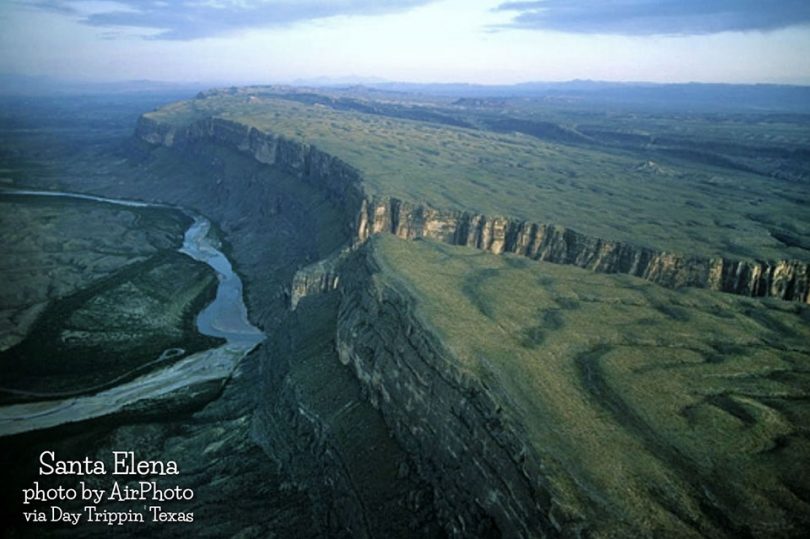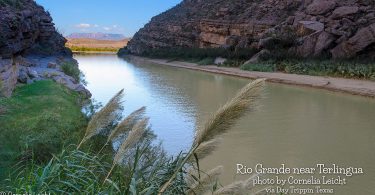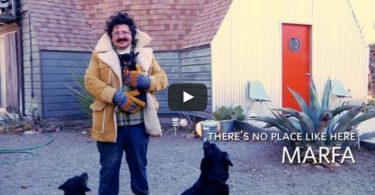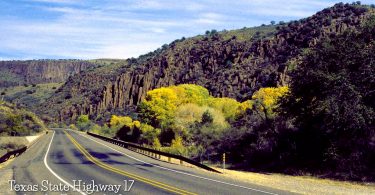Crowned with a sky so wide that it threatens to define infinity, the Big Bend region of Texas is situated roughly west of San Antonio, east of El Paso, and north of the mythic Rio Grande river. It remains one of the last true frontiers in the Lower 48, a landscape unique in the world.
Overview Home to Big Bend National Park and the adjoining Big Bend Ranch State Park, this borderland is characterized by rugged mountain ranges, grassland, and immense tracts of desert. The region’s exotic qualities has long attracted Hollywood: Recent films No Country For Old Men and There Will Be Blood were filmed in the area, and the landscape prompted one 1930s inhabitant to call it “America’s Abyssinia,” perhaps for the African-style terrain and abundant wildlife. The route starts in the oil town of Fort Stockton, continues to Alpine—gateway to Big Bend National Park—and through Paisano Pass to the quirky town of Marfa. From here it threads south past the ghost town of Shafter into the border town of Presidio, then continues along scenic River Road (FM-170) through Terlingua to Study Butte. Turning onto Hwy. 118/Maverick Road, the drive unspools into that Texas jewel, Big Bend National Park. From here choices include detours to Chisos, a not-to-miss mountain chain, and the funky old cattle town of Marathon.
![]() Start in Fort Stockton An oil town, Fort Stockton has so far thrived despite the ups and downs of commodity prices. The site of a fort established in 1858 to protect travelers and settlers in Comanche territory—reconstructed fort buildings are open to visitors—the town serves as a base for day trips into Big Bend country, which includes Carlsbad Caverns and Davis Mountain.
Start in Fort Stockton An oil town, Fort Stockton has so far thrived despite the ups and downs of commodity prices. The site of a fort established in 1858 to protect travelers and settlers in Comanche territory—reconstructed fort buildings are open to visitors—the town serves as a base for day trips into Big Bend country, which includes Carlsbad Caverns and Davis Mountain.
![]() Alpine From Fort Stockton, head west on Interstate 10, then exit to continue south on 67 before heading west on Hwy. 90 into the town of Alpine. The region’s hub and a gateway to Big Bend National Park, Alpine is ringed by mountains and possesses the highest number of historic adobe structures in Texas outside of El Paso (found mostly on Alpine’s Southside). The traditional Mexican neighborhood is being revived by big city refugees, like Cristina Sousa and Vic Noriega, opening emporia such as the Murphy St. Raspa Company (100 W. Murphy St.; www.raspaland.com). The store specializes in raspas, or Mexican snow cones, and such hard-to-find Mexican imports as clay figurines and typical candies that evoke the cultural pride of a resurgent community. On the campus of Sul Ross State University, the recently redone Museum of the Big Bend (www.sulross.edu/~museum) features exhibits on the entire region, including displays of fossils and photography. Eats in Alpine include the Trattoria (901 E. Holland Ave.; www.latrattoriacafe.com), a rustic Italian restaurant specializing in pasta dishes and thin-crust pizzas; and Alicia’s (708 E. Gallego Ave.), which serves stuffed breakfast burritos named after local patrons (try “the Dude”). Those keen to do as the locals do should join Alpine’s boot-clad lawyers and ranchers for a bourbon at Reata (203 N. 5th St.; www.reata.net).
Alpine From Fort Stockton, head west on Interstate 10, then exit to continue south on 67 before heading west on Hwy. 90 into the town of Alpine. The region’s hub and a gateway to Big Bend National Park, Alpine is ringed by mountains and possesses the highest number of historic adobe structures in Texas outside of El Paso (found mostly on Alpine’s Southside). The traditional Mexican neighborhood is being revived by big city refugees, like Cristina Sousa and Vic Noriega, opening emporia such as the Murphy St. Raspa Company (100 W. Murphy St.; www.raspaland.com). The store specializes in raspas, or Mexican snow cones, and such hard-to-find Mexican imports as clay figurines and typical candies that evoke the cultural pride of a resurgent community. On the campus of Sul Ross State University, the recently redone Museum of the Big Bend (www.sulross.edu/~museum) features exhibits on the entire region, including displays of fossils and photography. Eats in Alpine include the Trattoria (901 E. Holland Ave.; www.latrattoriacafe.com), a rustic Italian restaurant specializing in pasta dishes and thin-crust pizzas; and Alicia’s (708 E. Gallego Ave.), which serves stuffed breakfast burritos named after local patrons (try “the Dude”). Those keen to do as the locals do should join Alpine’s boot-clad lawyers and ranchers for a bourbon at Reata (203 N. 5th St.; www.reata.net).
![]() Marfa Leaving Alpine toward the west on Hwy. 90, cruise through photogenic Paisano Pass, dotted with juniper shrubs and dark outcroppings—the remains of an ancient volcano caldera. When you reach a grassy plateau, you’re approaching the Marfa Lights Viewing Stand, a modern building where visitors can look for the legendary floating spheres known as the Marfa lights. The town of Marfa has garnered attention for turning the Minimalist art movement into a design aesthetic embraced by artists and writers who have come here to live and work. Still, it’s the Hotel Paisano (207 N. Highland Ave.; www.hotelpaisano.com), an ornate Spanish Revival oasis and state historic landmark that offers the coolest respite from the West Texas sun: James Dean and Liz Taylor stayed here during the making of the 1956 epic film Giant. Another highlight here is the Chinati Foundation (1 Calvary Row; www.chinati.org), which was founded by modern sculptor Donald Judd to showcase his work—a spare arrangement of massive blocks of aluminum and stone.
Marfa Leaving Alpine toward the west on Hwy. 90, cruise through photogenic Paisano Pass, dotted with juniper shrubs and dark outcroppings—the remains of an ancient volcano caldera. When you reach a grassy plateau, you’re approaching the Marfa Lights Viewing Stand, a modern building where visitors can look for the legendary floating spheres known as the Marfa lights. The town of Marfa has garnered attention for turning the Minimalist art movement into a design aesthetic embraced by artists and writers who have come here to live and work. Still, it’s the Hotel Paisano (207 N. Highland Ave.; www.hotelpaisano.com), an ornate Spanish Revival oasis and state historic landmark that offers the coolest respite from the West Texas sun: James Dean and Liz Taylor stayed here during the making of the 1956 epic film Giant. Another highlight here is the Chinati Foundation (1 Calvary Row; www.chinati.org), which was founded by modern sculptor Donald Judd to showcase his work—a spare arrangement of massive blocks of aluminum and stone.
The Food Shark For decent grub, try the Food Shark, an RV dishing up Middle Eastern lunches across from the Marfa Book Company store (101 S. Highland Ave.; www.marfabookco.com). More sophisticated fare is found at Cochineal (109 W. San Antonio St.) and Blue Javelina (1300 W. San Antonio St.), both run by former New York chefs.
![]() Shafter Proceed south on Hwy. 67 toward the border town of Presidio, passing the ghost town of Shafter, nestled at the start of the Chinati Mountains. In the 1880s, silver was discovered here, leading to the establishment of the Presidio Mining Company. Now the town is deserted, its buildings abandoned to the wind—though day-trippers stop by to see the evocative ruins.
Shafter Proceed south on Hwy. 67 toward the border town of Presidio, passing the ghost town of Shafter, nestled at the start of the Chinati Mountains. In the 1880s, silver was discovered here, leading to the establishment of the Presidio Mining Company. Now the town is deserted, its buildings abandoned to the wind—though day-trippers stop by to see the evocative ruins.
![]() River Road From Shafter, drive to Presidio and pick up signs for the River Road (FM-170); the 67-mile (108-kilometer) stretch between Presidio and Study Butte offers photo-worthy scenery along the way. On your right are glimpses of the usually muddy Rio Grande, its banks half hidden by cane. Local resident Bill MacLeod, author of River Road Vistas, recommends the following: “Stop at the top of Big Hill overlooking the Santana Basin for the single best view in the whole world.” The road continues on, taking travelers past a Western-town movie set, the Lajitas resort, and through the town of Terlingua, home of feisty river runners who gather to drink at the cave bar La Kiva (Hwy. 170; www.lakiva.net). The River Road stops its course in Study Butte.
River Road From Shafter, drive to Presidio and pick up signs for the River Road (FM-170); the 67-mile (108-kilometer) stretch between Presidio and Study Butte offers photo-worthy scenery along the way. On your right are glimpses of the usually muddy Rio Grande, its banks half hidden by cane. Local resident Bill MacLeod, author of River Road Vistas, recommends the following: “Stop at the top of Big Hill overlooking the Santana Basin for the single best view in the whole world.” The road continues on, taking travelers past a Western-town movie set, the Lajitas resort, and through the town of Terlingua, home of feisty river runners who gather to drink at the cave bar La Kiva (Hwy. 170; www.lakiva.net). The River Road stops its course in Study Butte.
![]() End in Big Bend National Park
End in Big Bend National Park
From Study Butte, take Hwy. 118/Maverick Road into Big Bend National Park. Visitors can spend days exploring the 801,000-acre (324,000-hectare) park, but if you’re planning to only drive through, make a right onto Basin Road, a 6-mile (9.7-kilometer) spur that leads into the Chisos, a remote, picturesque mountain range located in the park’s midsection. Returning on Maverick Road to Panther Junction, follow Highway 385 toward I-10, which leads you through some rugged land and into the tiny haven of Marathon. Plan for a fine dinner at the village’s Gage Hotel (101 Hwy. 90 W.; www.gagehotel.com)—a great way to part company with Texas west of the Pecos.
Road Kit This drive is doable year-round, but is most enjoyable in spring and fall; winters can turn cold, while summers can be blisteringly hot. The nearest major airport is Midland, about a four-hour drive from the park. For more information about this borderlands region, see www.visitbigbend.com.
Text by Andrew Nelson, adapted from National Geographic Traveler | Photo by AirPhotoNA










